HNB3209 Essay: Chronic Kidney Disease Self-Management in the Community
VerifiedAdded on 2022/12/01
|13
|3240
|69
Essay
AI Summary
This essay delves into chronic kidney disease (CKD), exploring its causes, which include high blood pressure and type 2 diabetes, and its pathophysiology, highlighting the damage to kidneys leading to renal failure. The paper examines the impacts of CKD on individuals, families, and the community, including kidney failure, high blood pressure, and nerve damage, and the associated high treatment costs. It also discusses the importance of health promotion, cultural safety, and patient empowerment in managing CKD. Health promotion strategies include educating the community about risk factors and symptoms, while cultural safety emphasizes respectful communication and understanding of diverse beliefs. Patient empowerment involves providing hope and support. The essay underscores the need for effective self-management strategies to improve the quality of life for those living with CKD.
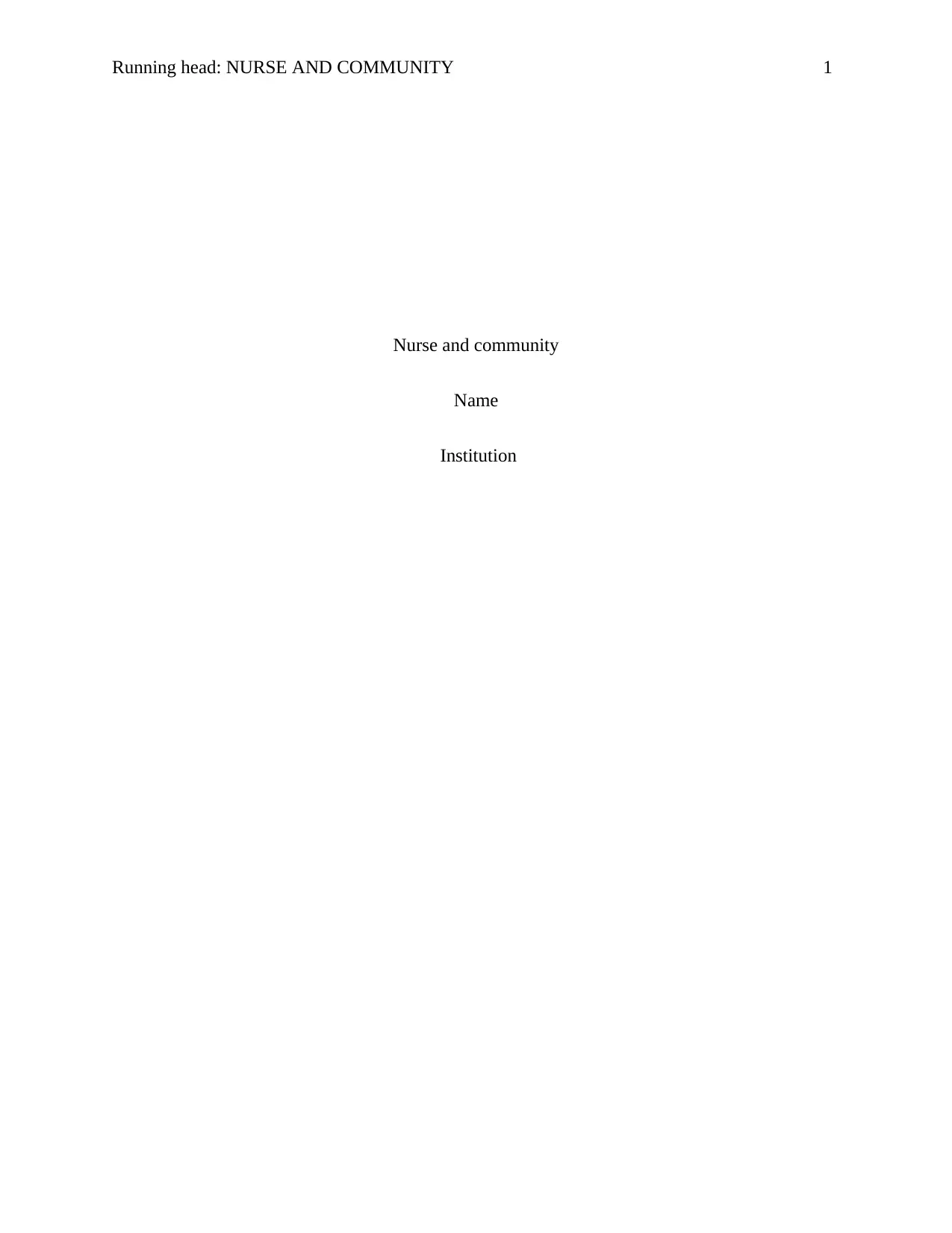
Running head: NURSE AND COMMUNITY 1
Nurse and community
Name
Institution
Nurse and community
Name
Institution
Paraphrase This Document
Need a fresh take? Get an instant paraphrase of this document with our AI Paraphraser
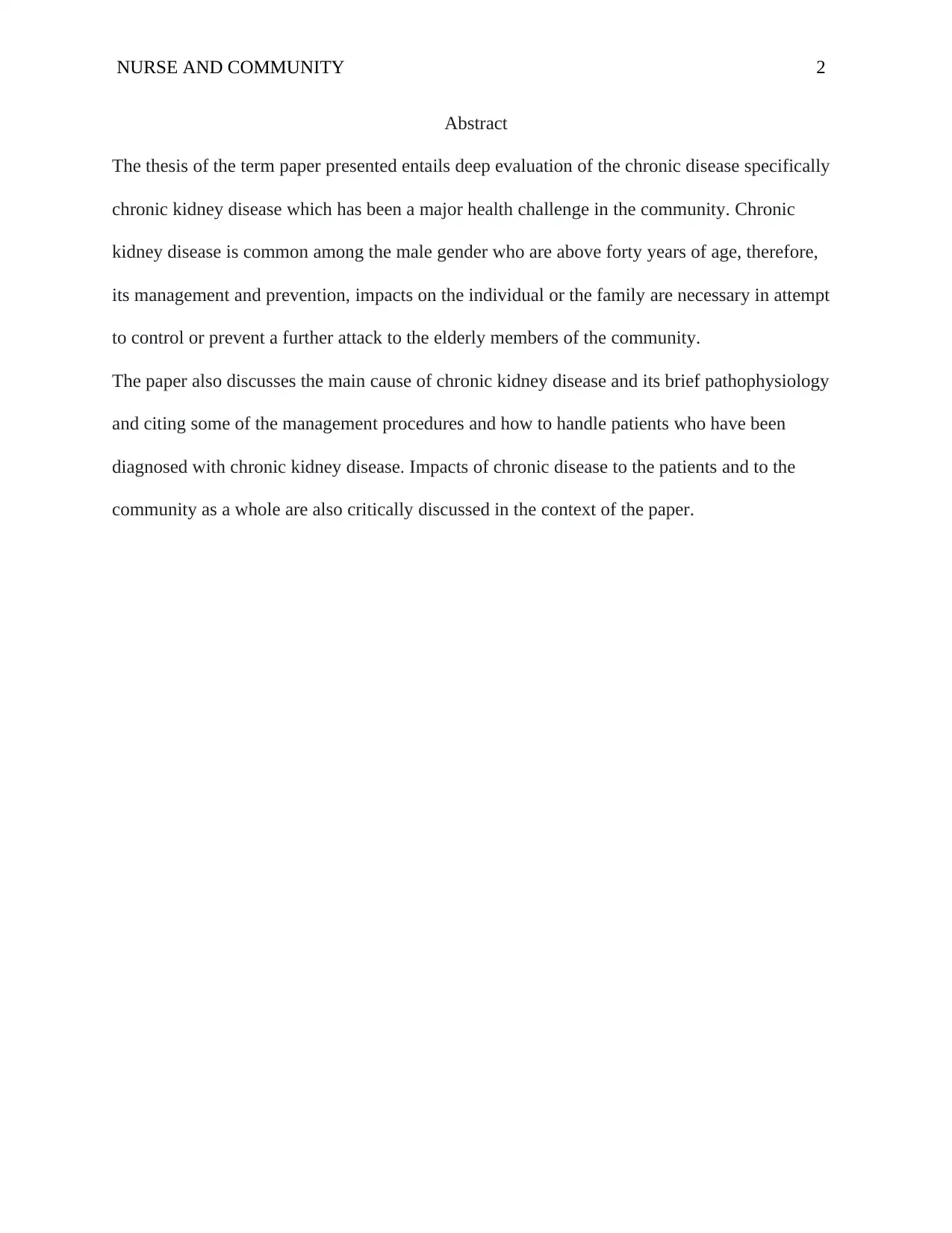
NURSE AND COMMUNITY 2
Abstract
The thesis of the term paper presented entails deep evaluation of the chronic disease specifically
chronic kidney disease which has been a major health challenge in the community. Chronic
kidney disease is common among the male gender who are above forty years of age, therefore,
its management and prevention, impacts on the individual or the family are necessary in attempt
to control or prevent a further attack to the elderly members of the community.
The paper also discusses the main cause of chronic kidney disease and its brief pathophysiology
and citing some of the management procedures and how to handle patients who have been
diagnosed with chronic kidney disease. Impacts of chronic disease to the patients and to the
community as a whole are also critically discussed in the context of the paper.
Abstract
The thesis of the term paper presented entails deep evaluation of the chronic disease specifically
chronic kidney disease which has been a major health challenge in the community. Chronic
kidney disease is common among the male gender who are above forty years of age, therefore,
its management and prevention, impacts on the individual or the family are necessary in attempt
to control or prevent a further attack to the elderly members of the community.
The paper also discusses the main cause of chronic kidney disease and its brief pathophysiology
and citing some of the management procedures and how to handle patients who have been
diagnosed with chronic kidney disease. Impacts of chronic disease to the patients and to the
community as a whole are also critically discussed in the context of the paper.
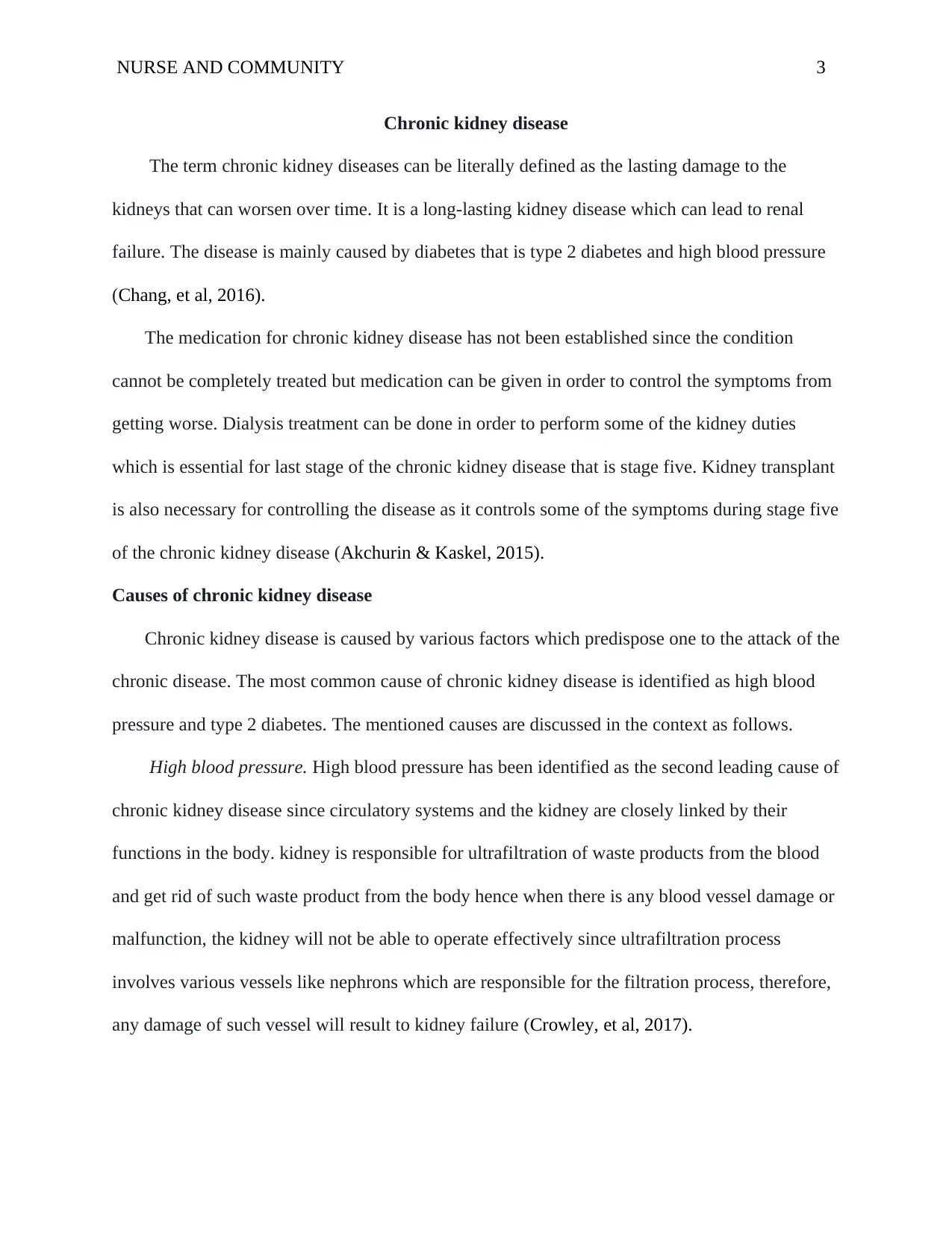
NURSE AND COMMUNITY 3
Chronic kidney disease
The term chronic kidney diseases can be literally defined as the lasting damage to the
kidneys that can worsen over time. It is a long-lasting kidney disease which can lead to renal
failure. The disease is mainly caused by diabetes that is type 2 diabetes and high blood pressure
(Chang, et al, 2016).
The medication for chronic kidney disease has not been established since the condition
cannot be completely treated but medication can be given in order to control the symptoms from
getting worse. Dialysis treatment can be done in order to perform some of the kidney duties
which is essential for last stage of the chronic kidney disease that is stage five. Kidney transplant
is also necessary for controlling the disease as it controls some of the symptoms during stage five
of the chronic kidney disease (Akchurin & Kaskel, 2015).
Causes of chronic kidney disease
Chronic kidney disease is caused by various factors which predispose one to the attack of the
chronic disease. The most common cause of chronic kidney disease is identified as high blood
pressure and type 2 diabetes. The mentioned causes are discussed in the context as follows.
High blood pressure. High blood pressure has been identified as the second leading cause of
chronic kidney disease since circulatory systems and the kidney are closely linked by their
functions in the body. kidney is responsible for ultrafiltration of waste products from the blood
and get rid of such waste product from the body hence when there is any blood vessel damage or
malfunction, the kidney will not be able to operate effectively since ultrafiltration process
involves various vessels like nephrons which are responsible for the filtration process, therefore,
any damage of such vessel will result to kidney failure (Crowley, et al, 2017).
Chronic kidney disease
The term chronic kidney diseases can be literally defined as the lasting damage to the
kidneys that can worsen over time. It is a long-lasting kidney disease which can lead to renal
failure. The disease is mainly caused by diabetes that is type 2 diabetes and high blood pressure
(Chang, et al, 2016).
The medication for chronic kidney disease has not been established since the condition
cannot be completely treated but medication can be given in order to control the symptoms from
getting worse. Dialysis treatment can be done in order to perform some of the kidney duties
which is essential for last stage of the chronic kidney disease that is stage five. Kidney transplant
is also necessary for controlling the disease as it controls some of the symptoms during stage five
of the chronic kidney disease (Akchurin & Kaskel, 2015).
Causes of chronic kidney disease
Chronic kidney disease is caused by various factors which predispose one to the attack of the
chronic disease. The most common cause of chronic kidney disease is identified as high blood
pressure and type 2 diabetes. The mentioned causes are discussed in the context as follows.
High blood pressure. High blood pressure has been identified as the second leading cause of
chronic kidney disease since circulatory systems and the kidney are closely linked by their
functions in the body. kidney is responsible for ultrafiltration of waste products from the blood
and get rid of such waste product from the body hence when there is any blood vessel damage or
malfunction, the kidney will not be able to operate effectively since ultrafiltration process
involves various vessels like nephrons which are responsible for the filtration process, therefore,
any damage of such vessel will result to kidney failure (Crowley, et al, 2017).
⊘ This is a preview!⊘
Do you want full access?
Subscribe today to unlock all pages.

Trusted by 1+ million students worldwide
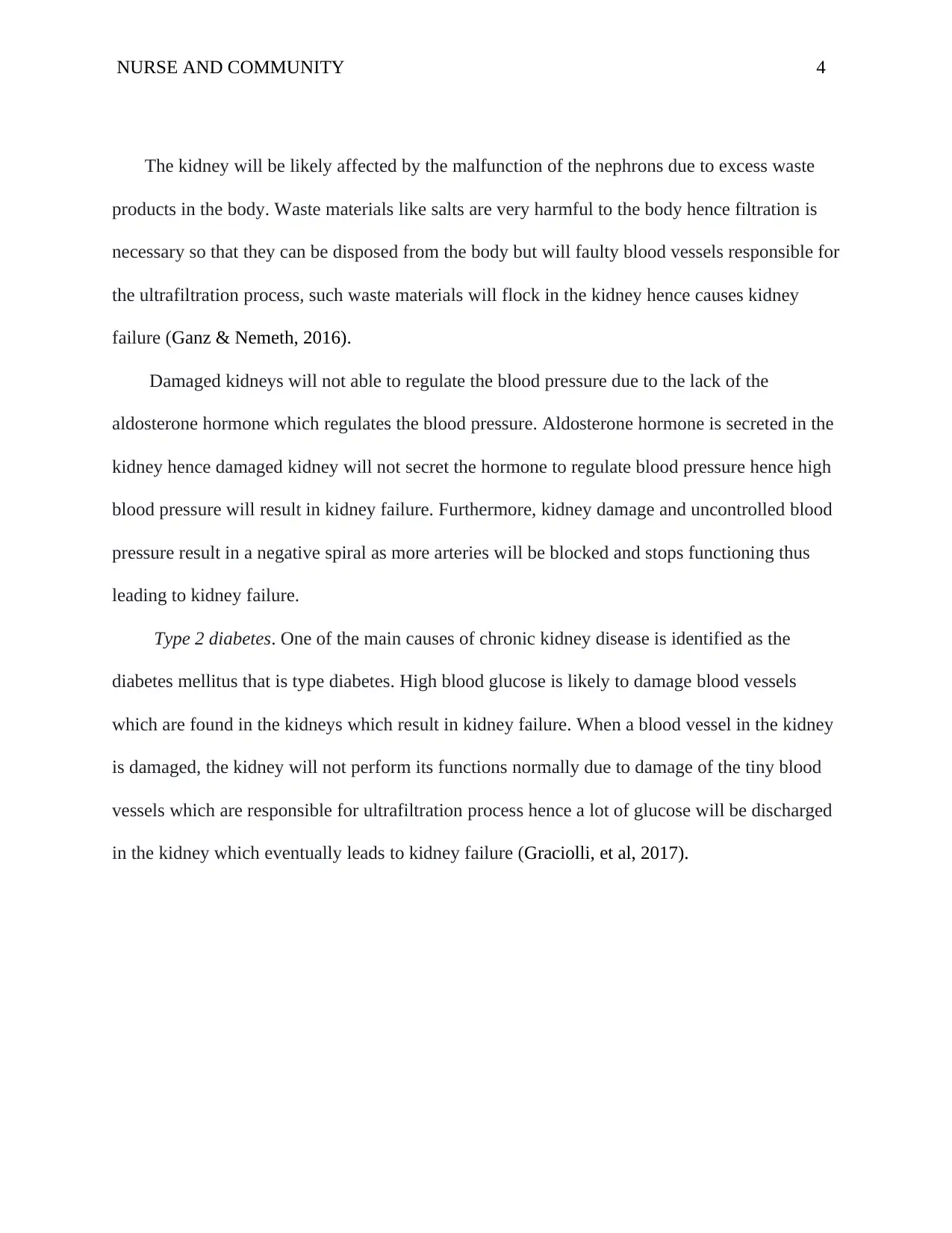
NURSE AND COMMUNITY 4
The kidney will be likely affected by the malfunction of the nephrons due to excess waste
products in the body. Waste materials like salts are very harmful to the body hence filtration is
necessary so that they can be disposed from the body but will faulty blood vessels responsible for
the ultrafiltration process, such waste materials will flock in the kidney hence causes kidney
failure (Ganz & Nemeth, 2016).
Damaged kidneys will not able to regulate the blood pressure due to the lack of the
aldosterone hormone which regulates the blood pressure. Aldosterone hormone is secreted in the
kidney hence damaged kidney will not secret the hormone to regulate blood pressure hence high
blood pressure will result in kidney failure. Furthermore, kidney damage and uncontrolled blood
pressure result in a negative spiral as more arteries will be blocked and stops functioning thus
leading to kidney failure.
Type 2 diabetes. One of the main causes of chronic kidney disease is identified as the
diabetes mellitus that is type diabetes. High blood glucose is likely to damage blood vessels
which are found in the kidneys which result in kidney failure. When a blood vessel in the kidney
is damaged, the kidney will not perform its functions normally due to damage of the tiny blood
vessels which are responsible for ultrafiltration process hence a lot of glucose will be discharged
in the kidney which eventually leads to kidney failure (Graciolli, et al, 2017).
The kidney will be likely affected by the malfunction of the nephrons due to excess waste
products in the body. Waste materials like salts are very harmful to the body hence filtration is
necessary so that they can be disposed from the body but will faulty blood vessels responsible for
the ultrafiltration process, such waste materials will flock in the kidney hence causes kidney
failure (Ganz & Nemeth, 2016).
Damaged kidneys will not able to regulate the blood pressure due to the lack of the
aldosterone hormone which regulates the blood pressure. Aldosterone hormone is secreted in the
kidney hence damaged kidney will not secret the hormone to regulate blood pressure hence high
blood pressure will result in kidney failure. Furthermore, kidney damage and uncontrolled blood
pressure result in a negative spiral as more arteries will be blocked and stops functioning thus
leading to kidney failure.
Type 2 diabetes. One of the main causes of chronic kidney disease is identified as the
diabetes mellitus that is type diabetes. High blood glucose is likely to damage blood vessels
which are found in the kidneys which result in kidney failure. When a blood vessel in the kidney
is damaged, the kidney will not perform its functions normally due to damage of the tiny blood
vessels which are responsible for ultrafiltration process hence a lot of glucose will be discharged
in the kidney which eventually leads to kidney failure (Graciolli, et al, 2017).
Paraphrase This Document
Need a fresh take? Get an instant paraphrase of this document with our AI Paraphraser
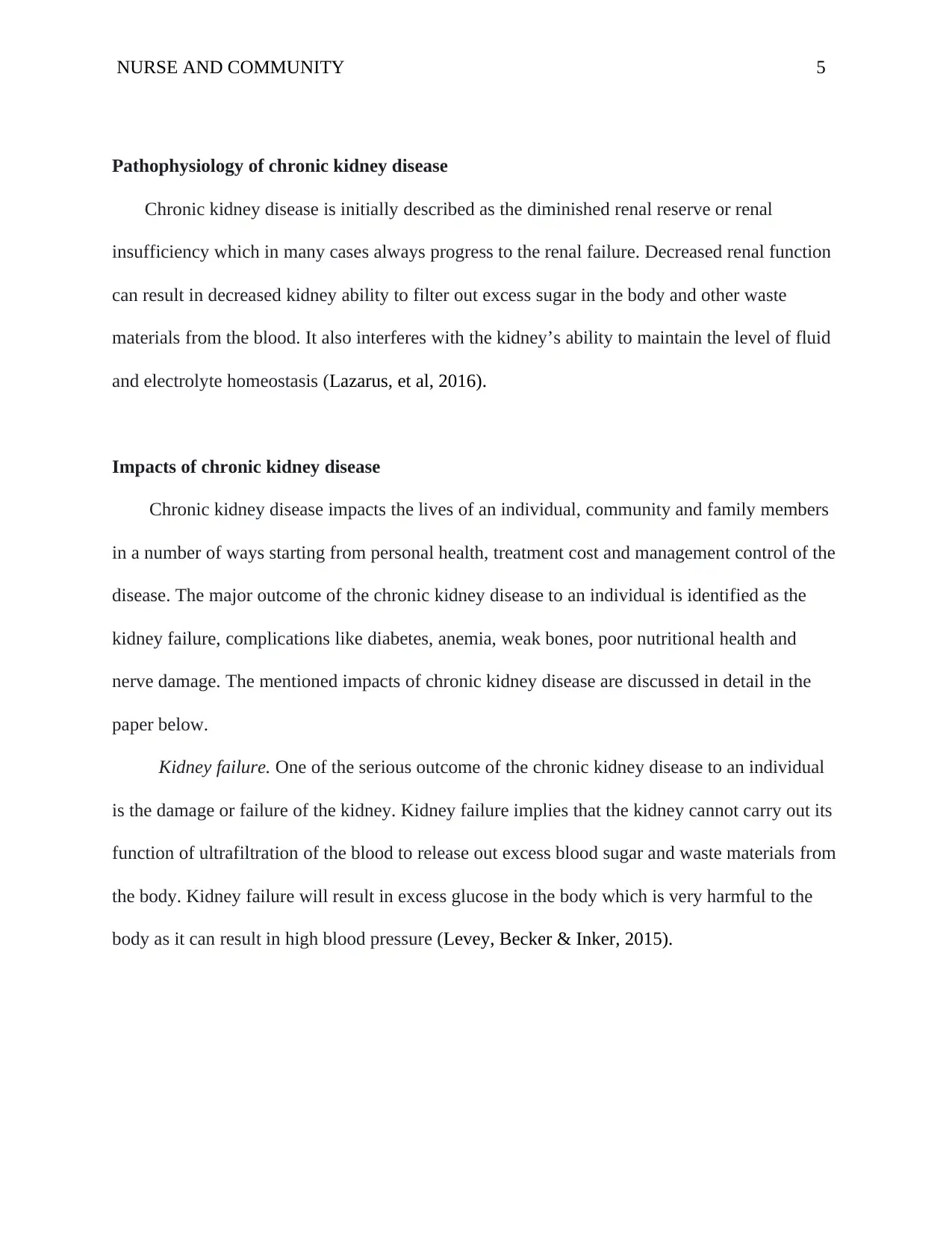
NURSE AND COMMUNITY 5
Pathophysiology of chronic kidney disease
Chronic kidney disease is initially described as the diminished renal reserve or renal
insufficiency which in many cases always progress to the renal failure. Decreased renal function
can result in decreased kidney ability to filter out excess sugar in the body and other waste
materials from the blood. It also interferes with the kidney’s ability to maintain the level of fluid
and electrolyte homeostasis (Lazarus, et al, 2016).
Impacts of chronic kidney disease
Chronic kidney disease impacts the lives of an individual, community and family members
in a number of ways starting from personal health, treatment cost and management control of the
disease. The major outcome of the chronic kidney disease to an individual is identified as the
kidney failure, complications like diabetes, anemia, weak bones, poor nutritional health and
nerve damage. The mentioned impacts of chronic kidney disease are discussed in detail in the
paper below.
Kidney failure. One of the serious outcome of the chronic kidney disease to an individual
is the damage or failure of the kidney. Kidney failure implies that the kidney cannot carry out its
function of ultrafiltration of the blood to release out excess blood sugar and waste materials from
the body. Kidney failure will result in excess glucose in the body which is very harmful to the
body as it can result in high blood pressure (Levey, Becker & Inker, 2015).
Pathophysiology of chronic kidney disease
Chronic kidney disease is initially described as the diminished renal reserve or renal
insufficiency which in many cases always progress to the renal failure. Decreased renal function
can result in decreased kidney ability to filter out excess sugar in the body and other waste
materials from the blood. It also interferes with the kidney’s ability to maintain the level of fluid
and electrolyte homeostasis (Lazarus, et al, 2016).
Impacts of chronic kidney disease
Chronic kidney disease impacts the lives of an individual, community and family members
in a number of ways starting from personal health, treatment cost and management control of the
disease. The major outcome of the chronic kidney disease to an individual is identified as the
kidney failure, complications like diabetes, anemia, weak bones, poor nutritional health and
nerve damage. The mentioned impacts of chronic kidney disease are discussed in detail in the
paper below.
Kidney failure. One of the serious outcome of the chronic kidney disease to an individual
is the damage or failure of the kidney. Kidney failure implies that the kidney cannot carry out its
function of ultrafiltration of the blood to release out excess blood sugar and waste materials from
the body. Kidney failure will result in excess glucose in the body which is very harmful to the
body as it can result in high blood pressure (Levey, Becker & Inker, 2015).
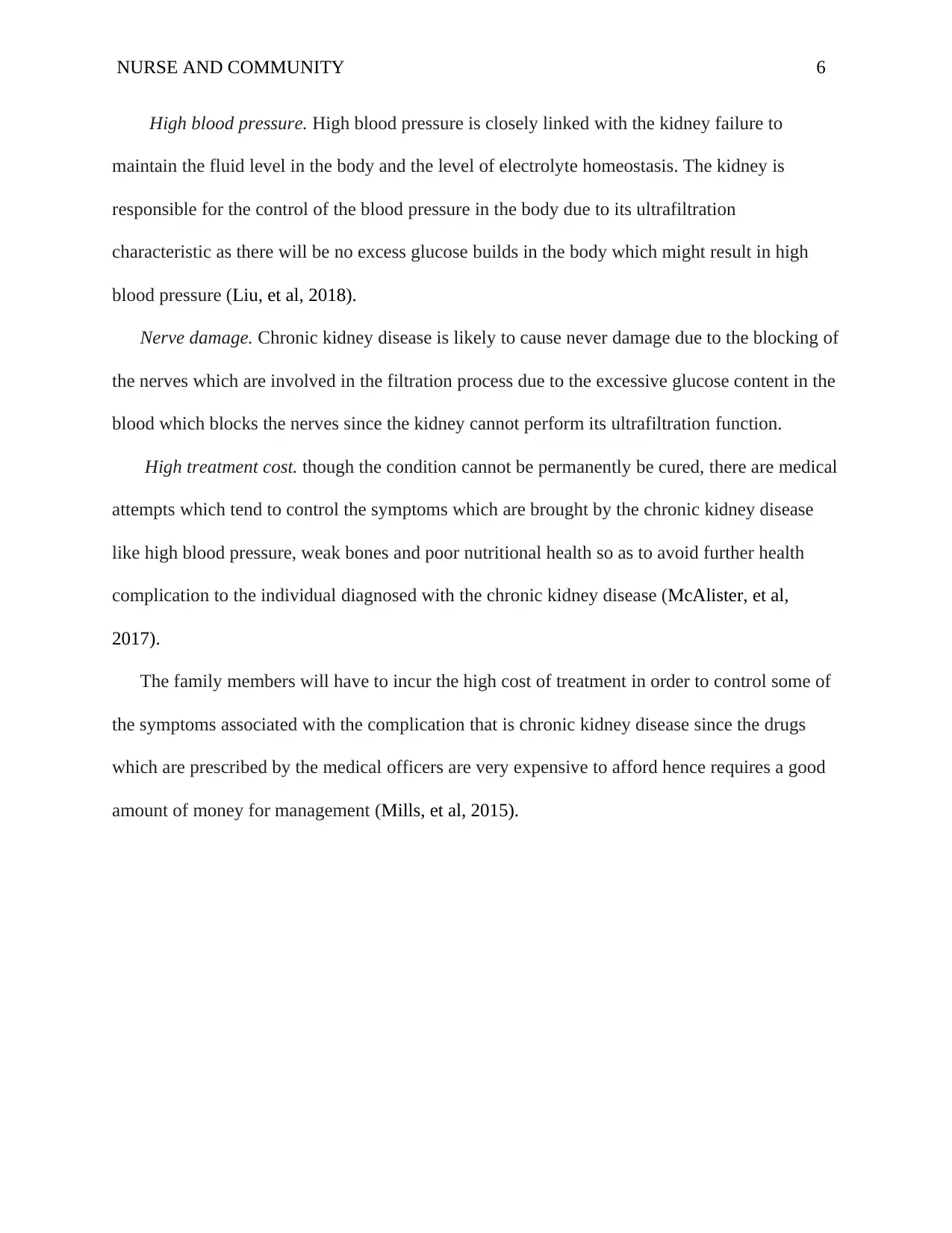
NURSE AND COMMUNITY 6
High blood pressure. High blood pressure is closely linked with the kidney failure to
maintain the fluid level in the body and the level of electrolyte homeostasis. The kidney is
responsible for the control of the blood pressure in the body due to its ultrafiltration
characteristic as there will be no excess glucose builds in the body which might result in high
blood pressure (Liu, et al, 2018).
Nerve damage. Chronic kidney disease is likely to cause never damage due to the blocking of
the nerves which are involved in the filtration process due to the excessive glucose content in the
blood which blocks the nerves since the kidney cannot perform its ultrafiltration function.
High treatment cost. though the condition cannot be permanently be cured, there are medical
attempts which tend to control the symptoms which are brought by the chronic kidney disease
like high blood pressure, weak bones and poor nutritional health so as to avoid further health
complication to the individual diagnosed with the chronic kidney disease (McAlister, et al,
2017).
The family members will have to incur the high cost of treatment in order to control some of
the symptoms associated with the complication that is chronic kidney disease since the drugs
which are prescribed by the medical officers are very expensive to afford hence requires a good
amount of money for management (Mills, et al, 2015).
High blood pressure. High blood pressure is closely linked with the kidney failure to
maintain the fluid level in the body and the level of electrolyte homeostasis. The kidney is
responsible for the control of the blood pressure in the body due to its ultrafiltration
characteristic as there will be no excess glucose builds in the body which might result in high
blood pressure (Liu, et al, 2018).
Nerve damage. Chronic kidney disease is likely to cause never damage due to the blocking of
the nerves which are involved in the filtration process due to the excessive glucose content in the
blood which blocks the nerves since the kidney cannot perform its ultrafiltration function.
High treatment cost. though the condition cannot be permanently be cured, there are medical
attempts which tend to control the symptoms which are brought by the chronic kidney disease
like high blood pressure, weak bones and poor nutritional health so as to avoid further health
complication to the individual diagnosed with the chronic kidney disease (McAlister, et al,
2017).
The family members will have to incur the high cost of treatment in order to control some of
the symptoms associated with the complication that is chronic kidney disease since the drugs
which are prescribed by the medical officers are very expensive to afford hence requires a good
amount of money for management (Mills, et al, 2015).
⊘ This is a preview!⊘
Do you want full access?
Subscribe today to unlock all pages.

Trusted by 1+ million students worldwide
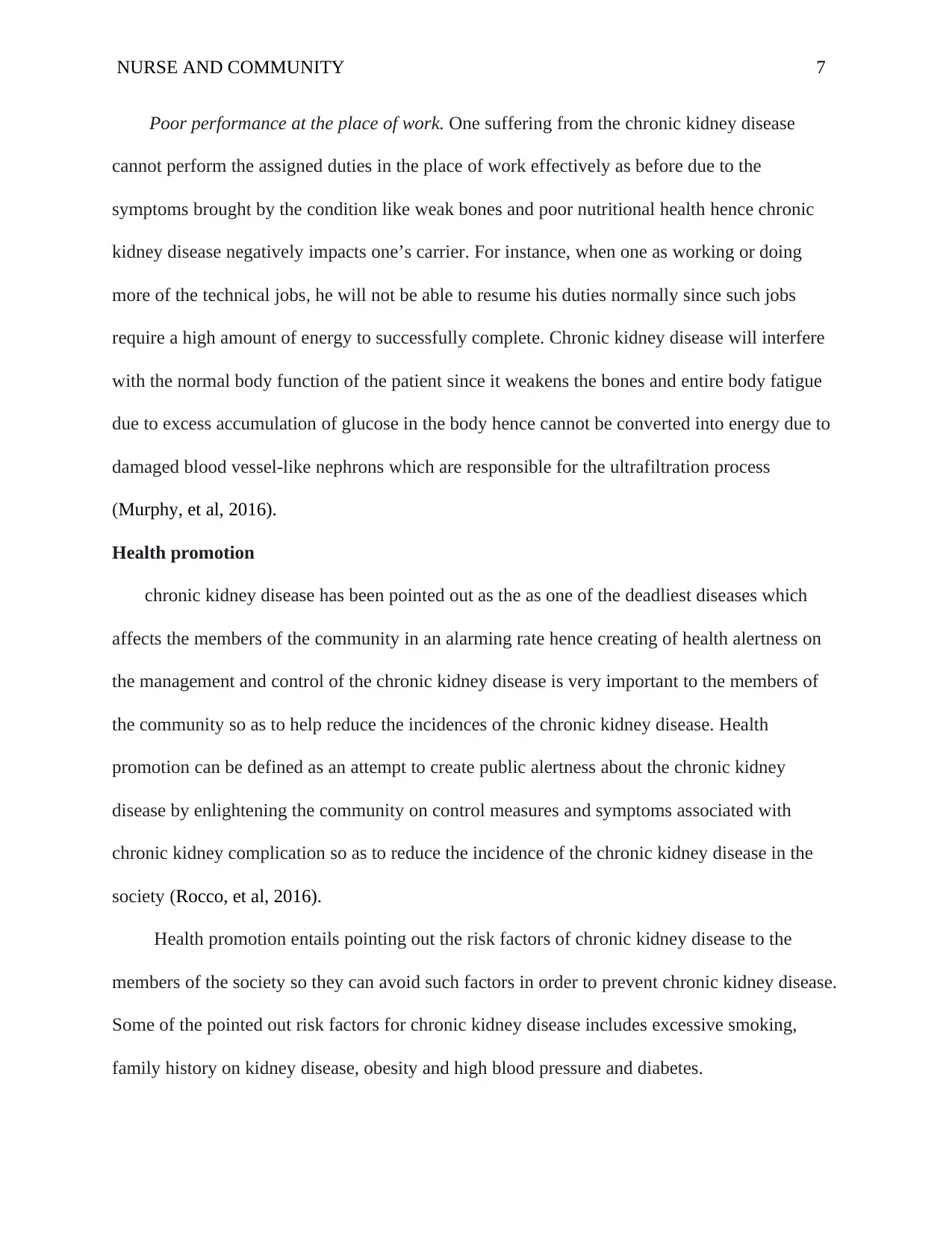
NURSE AND COMMUNITY 7
Poor performance at the place of work. One suffering from the chronic kidney disease
cannot perform the assigned duties in the place of work effectively as before due to the
symptoms brought by the condition like weak bones and poor nutritional health hence chronic
kidney disease negatively impacts one’s carrier. For instance, when one as working or doing
more of the technical jobs, he will not be able to resume his duties normally since such jobs
require a high amount of energy to successfully complete. Chronic kidney disease will interfere
with the normal body function of the patient since it weakens the bones and entire body fatigue
due to excess accumulation of glucose in the body hence cannot be converted into energy due to
damaged blood vessel-like nephrons which are responsible for the ultrafiltration process
(Murphy, et al, 2016).
Health promotion
chronic kidney disease has been pointed out as the as one of the deadliest diseases which
affects the members of the community in an alarming rate hence creating of health alertness on
the management and control of the chronic kidney disease is very important to the members of
the community so as to help reduce the incidences of the chronic kidney disease. Health
promotion can be defined as an attempt to create public alertness about the chronic kidney
disease by enlightening the community on control measures and symptoms associated with
chronic kidney complication so as to reduce the incidence of the chronic kidney disease in the
society (Rocco, et al, 2016).
Health promotion entails pointing out the risk factors of chronic kidney disease to the
members of the society so they can avoid such factors in order to prevent chronic kidney disease.
Some of the pointed out risk factors for chronic kidney disease includes excessive smoking,
family history on kidney disease, obesity and high blood pressure and diabetes.
Poor performance at the place of work. One suffering from the chronic kidney disease
cannot perform the assigned duties in the place of work effectively as before due to the
symptoms brought by the condition like weak bones and poor nutritional health hence chronic
kidney disease negatively impacts one’s carrier. For instance, when one as working or doing
more of the technical jobs, he will not be able to resume his duties normally since such jobs
require a high amount of energy to successfully complete. Chronic kidney disease will interfere
with the normal body function of the patient since it weakens the bones and entire body fatigue
due to excess accumulation of glucose in the body hence cannot be converted into energy due to
damaged blood vessel-like nephrons which are responsible for the ultrafiltration process
(Murphy, et al, 2016).
Health promotion
chronic kidney disease has been pointed out as the as one of the deadliest diseases which
affects the members of the community in an alarming rate hence creating of health alertness on
the management and control of the chronic kidney disease is very important to the members of
the community so as to help reduce the incidences of the chronic kidney disease. Health
promotion can be defined as an attempt to create public alertness about the chronic kidney
disease by enlightening the community on control measures and symptoms associated with
chronic kidney complication so as to reduce the incidence of the chronic kidney disease in the
society (Rocco, et al, 2016).
Health promotion entails pointing out the risk factors of chronic kidney disease to the
members of the society so they can avoid such factors in order to prevent chronic kidney disease.
Some of the pointed out risk factors for chronic kidney disease includes excessive smoking,
family history on kidney disease, obesity and high blood pressure and diabetes.
Paraphrase This Document
Need a fresh take? Get an instant paraphrase of this document with our AI Paraphraser
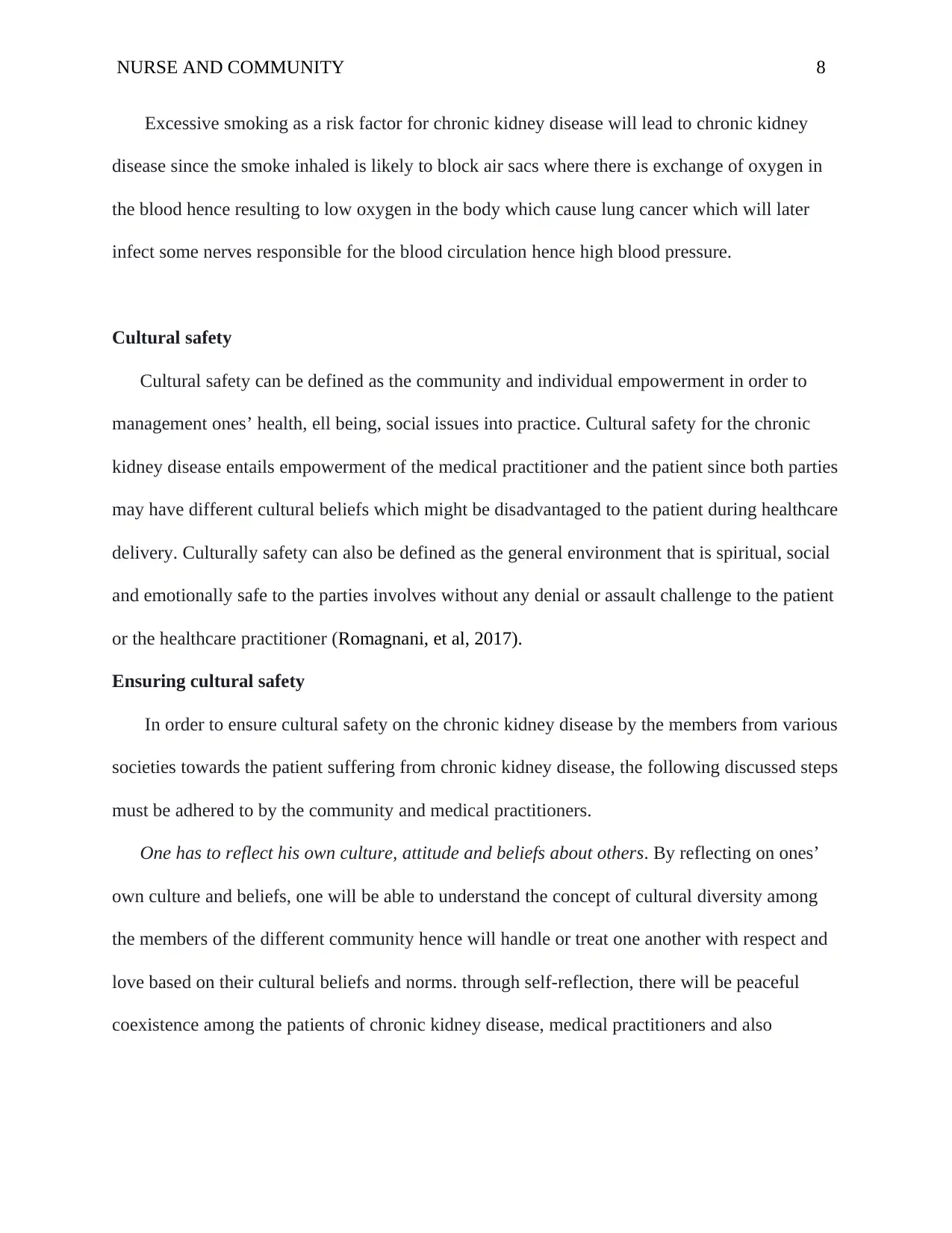
NURSE AND COMMUNITY 8
Excessive smoking as a risk factor for chronic kidney disease will lead to chronic kidney
disease since the smoke inhaled is likely to block air sacs where there is exchange of oxygen in
the blood hence resulting to low oxygen in the body which cause lung cancer which will later
infect some nerves responsible for the blood circulation hence high blood pressure.
Cultural safety
Cultural safety can be defined as the community and individual empowerment in order to
management ones’ health, ell being, social issues into practice. Cultural safety for the chronic
kidney disease entails empowerment of the medical practitioner and the patient since both parties
may have different cultural beliefs which might be disadvantaged to the patient during healthcare
delivery. Culturally safety can also be defined as the general environment that is spiritual, social
and emotionally safe to the parties involves without any denial or assault challenge to the patient
or the healthcare practitioner (Romagnani, et al, 2017).
Ensuring cultural safety
In order to ensure cultural safety on the chronic kidney disease by the members from various
societies towards the patient suffering from chronic kidney disease, the following discussed steps
must be adhered to by the community and medical practitioners.
One has to reflect his own culture, attitude and beliefs about others. By reflecting on ones’
own culture and beliefs, one will be able to understand the concept of cultural diversity among
the members of the different community hence will handle or treat one another with respect and
love based on their cultural beliefs and norms. through self-reflection, there will be peaceful
coexistence among the patients of chronic kidney disease, medical practitioners and also
Excessive smoking as a risk factor for chronic kidney disease will lead to chronic kidney
disease since the smoke inhaled is likely to block air sacs where there is exchange of oxygen in
the blood hence resulting to low oxygen in the body which cause lung cancer which will later
infect some nerves responsible for the blood circulation hence high blood pressure.
Cultural safety
Cultural safety can be defined as the community and individual empowerment in order to
management ones’ health, ell being, social issues into practice. Cultural safety for the chronic
kidney disease entails empowerment of the medical practitioner and the patient since both parties
may have different cultural beliefs which might be disadvantaged to the patient during healthcare
delivery. Culturally safety can also be defined as the general environment that is spiritual, social
and emotionally safe to the parties involves without any denial or assault challenge to the patient
or the healthcare practitioner (Romagnani, et al, 2017).
Ensuring cultural safety
In order to ensure cultural safety on the chronic kidney disease by the members from various
societies towards the patient suffering from chronic kidney disease, the following discussed steps
must be adhered to by the community and medical practitioners.
One has to reflect his own culture, attitude and beliefs about others. By reflecting on ones’
own culture and beliefs, one will be able to understand the concept of cultural diversity among
the members of the different community hence will handle or treat one another with respect and
love based on their cultural beliefs and norms. through self-reflection, there will be peaceful
coexistence among the patients of chronic kidney disease, medical practitioners and also
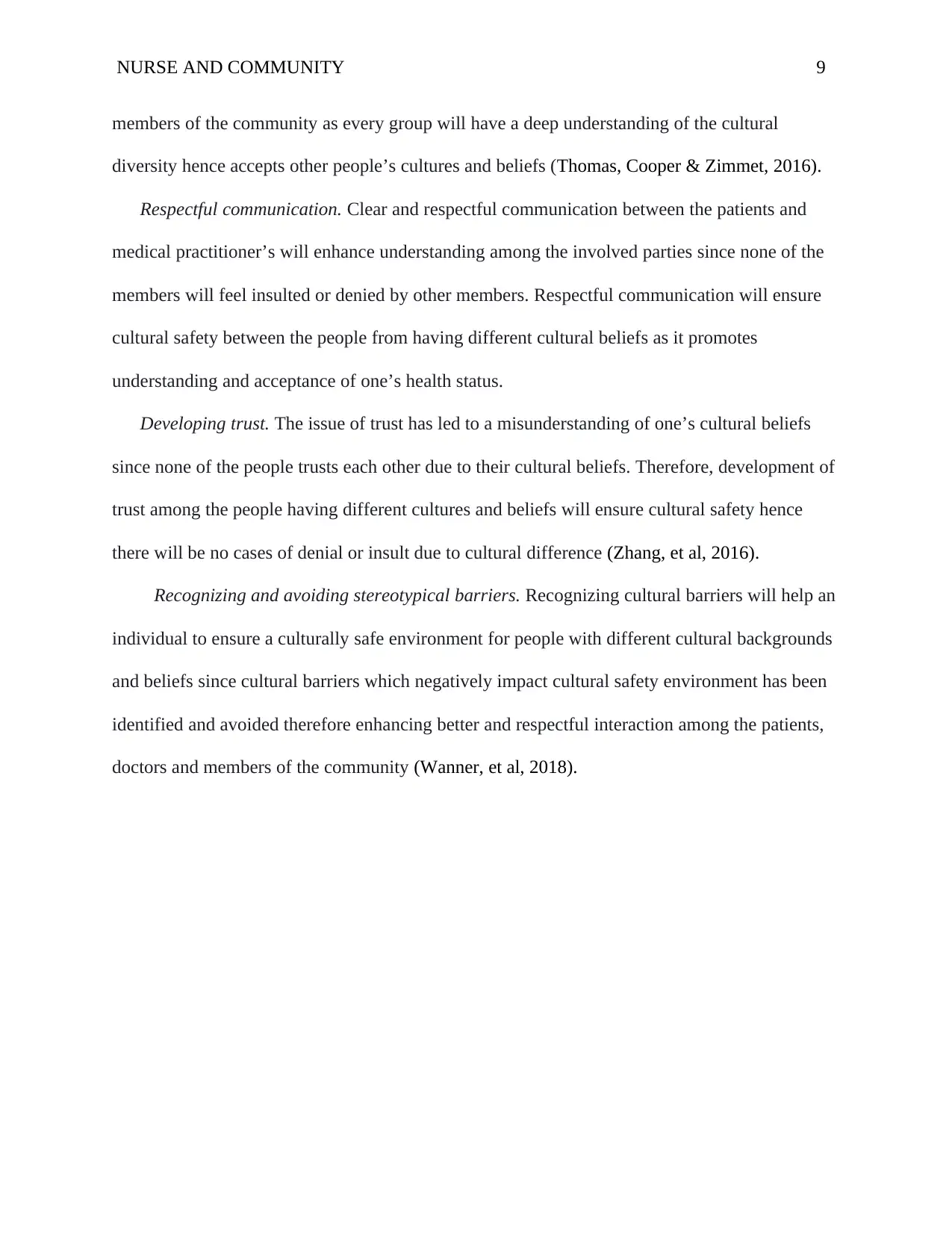
NURSE AND COMMUNITY 9
members of the community as every group will have a deep understanding of the cultural
diversity hence accepts other people’s cultures and beliefs (Thomas, Cooper & Zimmet, 2016).
Respectful communication. Clear and respectful communication between the patients and
medical practitioner’s will enhance understanding among the involved parties since none of the
members will feel insulted or denied by other members. Respectful communication will ensure
cultural safety between the people from having different cultural beliefs as it promotes
understanding and acceptance of one’s health status.
Developing trust. The issue of trust has led to a misunderstanding of one’s cultural beliefs
since none of the people trusts each other due to their cultural beliefs. Therefore, development of
trust among the people having different cultures and beliefs will ensure cultural safety hence
there will be no cases of denial or insult due to cultural difference (Zhang, et al, 2016).
Recognizing and avoiding stereotypical barriers. Recognizing cultural barriers will help an
individual to ensure a culturally safe environment for people with different cultural backgrounds
and beliefs since cultural barriers which negatively impact cultural safety environment has been
identified and avoided therefore enhancing better and respectful interaction among the patients,
doctors and members of the community (Wanner, et al, 2018).
members of the community as every group will have a deep understanding of the cultural
diversity hence accepts other people’s cultures and beliefs (Thomas, Cooper & Zimmet, 2016).
Respectful communication. Clear and respectful communication between the patients and
medical practitioner’s will enhance understanding among the involved parties since none of the
members will feel insulted or denied by other members. Respectful communication will ensure
cultural safety between the people from having different cultural beliefs as it promotes
understanding and acceptance of one’s health status.
Developing trust. The issue of trust has led to a misunderstanding of one’s cultural beliefs
since none of the people trusts each other due to their cultural beliefs. Therefore, development of
trust among the people having different cultures and beliefs will ensure cultural safety hence
there will be no cases of denial or insult due to cultural difference (Zhang, et al, 2016).
Recognizing and avoiding stereotypical barriers. Recognizing cultural barriers will help an
individual to ensure a culturally safe environment for people with different cultural backgrounds
and beliefs since cultural barriers which negatively impact cultural safety environment has been
identified and avoided therefore enhancing better and respectful interaction among the patients,
doctors and members of the community (Wanner, et al, 2018).
⊘ This is a preview!⊘
Do you want full access?
Subscribe today to unlock all pages.

Trusted by 1+ million students worldwide
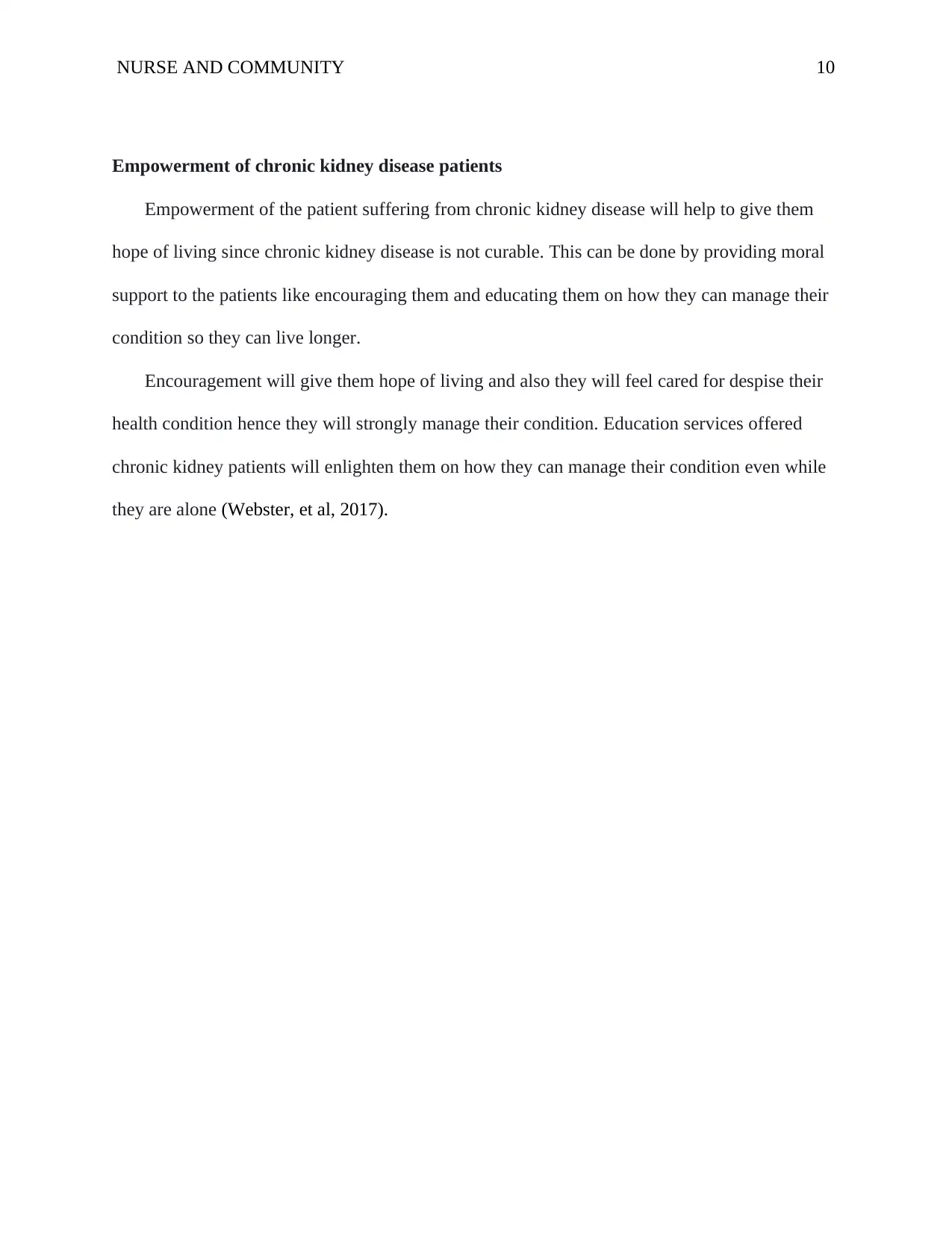
NURSE AND COMMUNITY 10
Empowerment of chronic kidney disease patients
Empowerment of the patient suffering from chronic kidney disease will help to give them
hope of living since chronic kidney disease is not curable. This can be done by providing moral
support to the patients like encouraging them and educating them on how they can manage their
condition so they can live longer.
Encouragement will give them hope of living and also they will feel cared for despise their
health condition hence they will strongly manage their condition. Education services offered
chronic kidney patients will enlighten them on how they can manage their condition even while
they are alone (Webster, et al, 2017).
Empowerment of chronic kidney disease patients
Empowerment of the patient suffering from chronic kidney disease will help to give them
hope of living since chronic kidney disease is not curable. This can be done by providing moral
support to the patients like encouraging them and educating them on how they can manage their
condition so they can live longer.
Encouragement will give them hope of living and also they will feel cared for despise their
health condition hence they will strongly manage their condition. Education services offered
chronic kidney patients will enlighten them on how they can manage their condition even while
they are alone (Webster, et al, 2017).
Paraphrase This Document
Need a fresh take? Get an instant paraphrase of this document with our AI Paraphraser
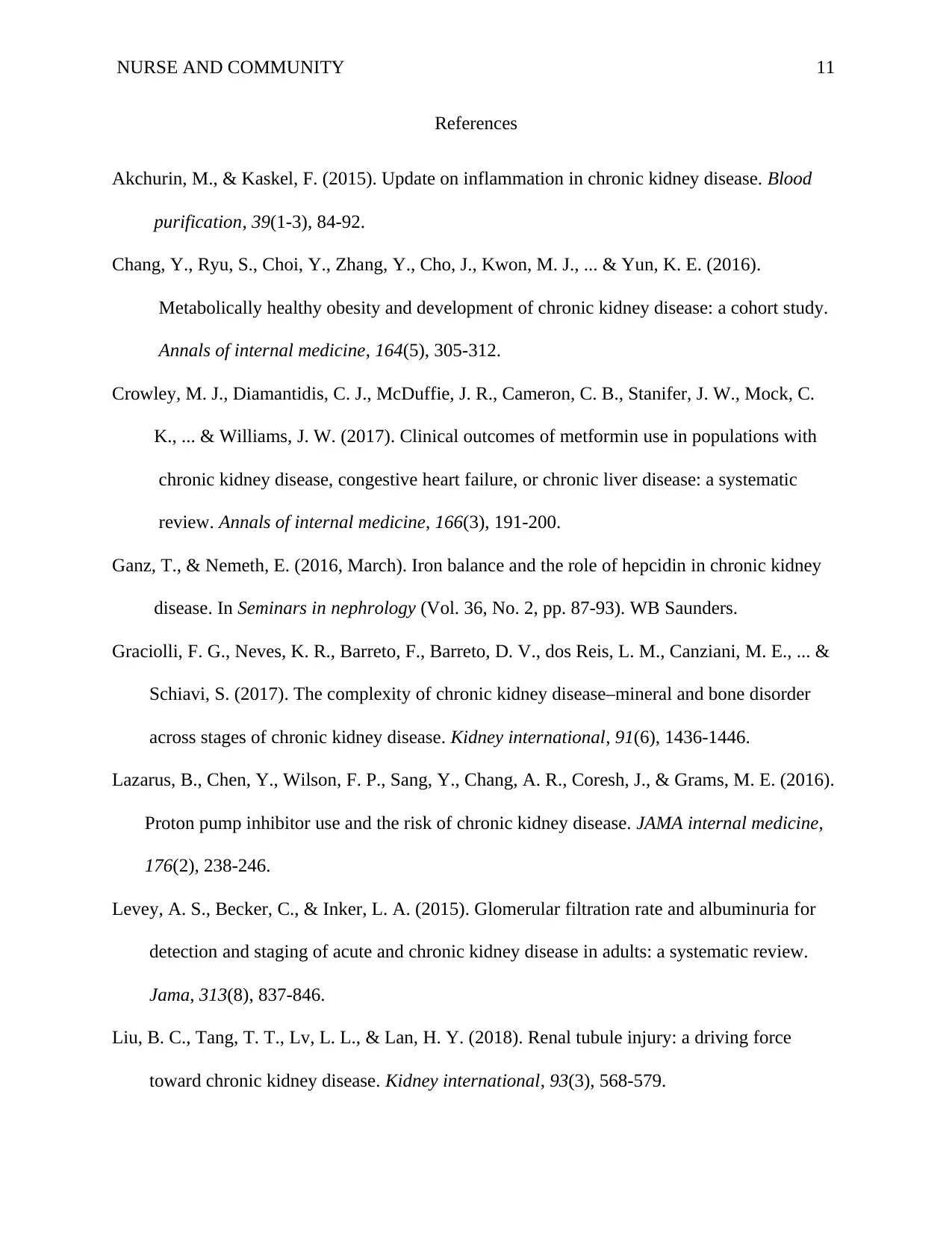
NURSE AND COMMUNITY 11
References
Akchurin, M., & Kaskel, F. (2015). Update on inflammation in chronic kidney disease. Blood
purification, 39(1-3), 84-92.
Chang, Y., Ryu, S., Choi, Y., Zhang, Y., Cho, J., Kwon, M. J., ... & Yun, K. E. (2016).
Metabolically healthy obesity and development of chronic kidney disease: a cohort study.
Annals of internal medicine, 164(5), 305-312.
Crowley, M. J., Diamantidis, C. J., McDuffie, J. R., Cameron, C. B., Stanifer, J. W., Mock, C.
K., ... & Williams, J. W. (2017). Clinical outcomes of metformin use in populations with
chronic kidney disease, congestive heart failure, or chronic liver disease: a systematic
review. Annals of internal medicine, 166(3), 191-200.
Ganz, T., & Nemeth, E. (2016, March). Iron balance and the role of hepcidin in chronic kidney
disease. In Seminars in nephrology (Vol. 36, No. 2, pp. 87-93). WB Saunders.
Graciolli, F. G., Neves, K. R., Barreto, F., Barreto, D. V., dos Reis, L. M., Canziani, M. E., ... &
Schiavi, S. (2017). The complexity of chronic kidney disease–mineral and bone disorder
across stages of chronic kidney disease. Kidney international, 91(6), 1436-1446.
Lazarus, B., Chen, Y., Wilson, F. P., Sang, Y., Chang, A. R., Coresh, J., & Grams, M. E. (2016).
Proton pump inhibitor use and the risk of chronic kidney disease. JAMA internal medicine,
176(2), 238-246.
Levey, A. S., Becker, C., & Inker, L. A. (2015). Glomerular filtration rate and albuminuria for
detection and staging of acute and chronic kidney disease in adults: a systematic review.
Jama, 313(8), 837-846.
Liu, B. C., Tang, T. T., Lv, L. L., & Lan, H. Y. (2018). Renal tubule injury: a driving force
toward chronic kidney disease. Kidney international, 93(3), 568-579.
References
Akchurin, M., & Kaskel, F. (2015). Update on inflammation in chronic kidney disease. Blood
purification, 39(1-3), 84-92.
Chang, Y., Ryu, S., Choi, Y., Zhang, Y., Cho, J., Kwon, M. J., ... & Yun, K. E. (2016).
Metabolically healthy obesity and development of chronic kidney disease: a cohort study.
Annals of internal medicine, 164(5), 305-312.
Crowley, M. J., Diamantidis, C. J., McDuffie, J. R., Cameron, C. B., Stanifer, J. W., Mock, C.
K., ... & Williams, J. W. (2017). Clinical outcomes of metformin use in populations with
chronic kidney disease, congestive heart failure, or chronic liver disease: a systematic
review. Annals of internal medicine, 166(3), 191-200.
Ganz, T., & Nemeth, E. (2016, March). Iron balance and the role of hepcidin in chronic kidney
disease. In Seminars in nephrology (Vol. 36, No. 2, pp. 87-93). WB Saunders.
Graciolli, F. G., Neves, K. R., Barreto, F., Barreto, D. V., dos Reis, L. M., Canziani, M. E., ... &
Schiavi, S. (2017). The complexity of chronic kidney disease–mineral and bone disorder
across stages of chronic kidney disease. Kidney international, 91(6), 1436-1446.
Lazarus, B., Chen, Y., Wilson, F. P., Sang, Y., Chang, A. R., Coresh, J., & Grams, M. E. (2016).
Proton pump inhibitor use and the risk of chronic kidney disease. JAMA internal medicine,
176(2), 238-246.
Levey, A. S., Becker, C., & Inker, L. A. (2015). Glomerular filtration rate and albuminuria for
detection and staging of acute and chronic kidney disease in adults: a systematic review.
Jama, 313(8), 837-846.
Liu, B. C., Tang, T. T., Lv, L. L., & Lan, H. Y. (2018). Renal tubule injury: a driving force
toward chronic kidney disease. Kidney international, 93(3), 568-579.
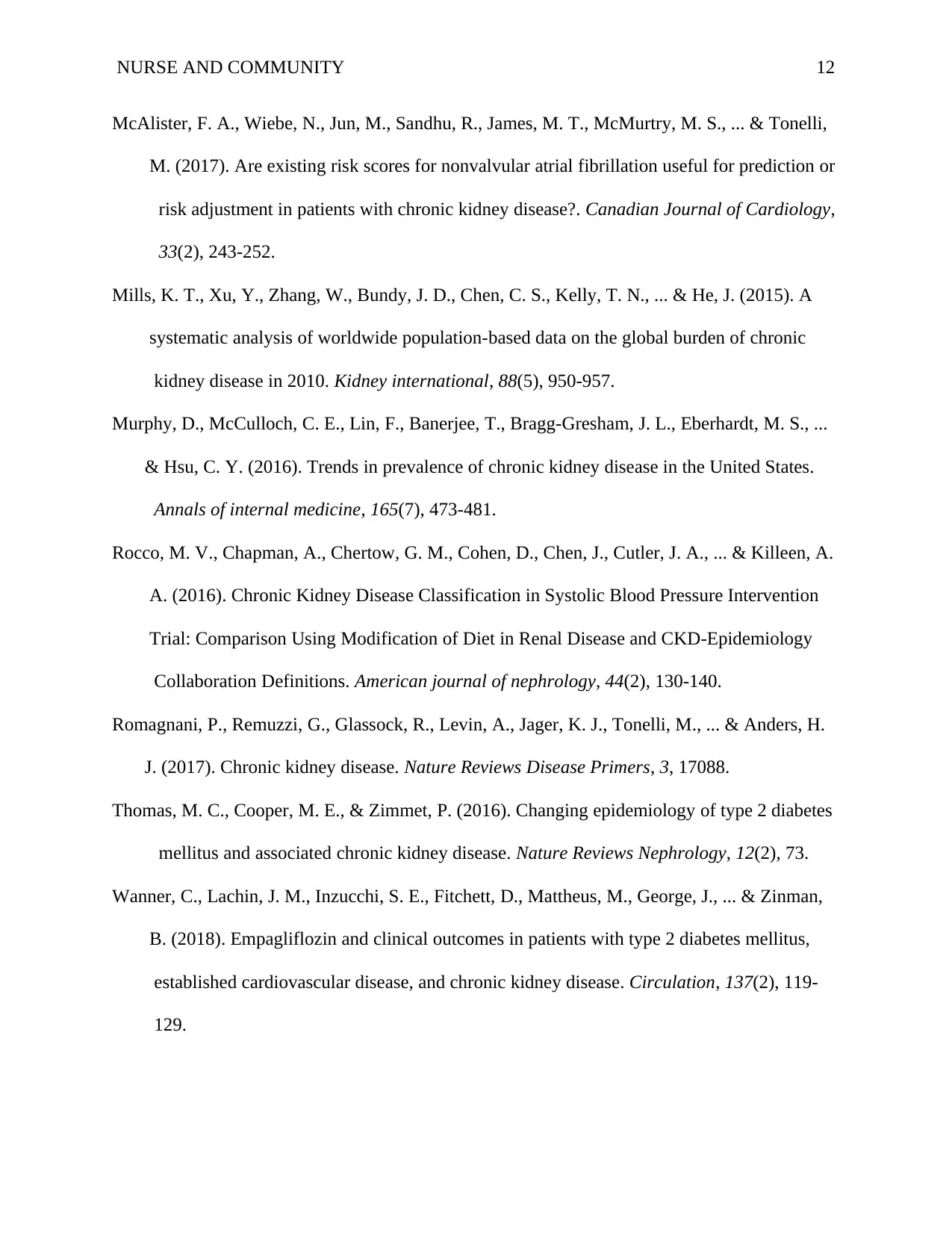
NURSE AND COMMUNITY 12
McAlister, F. A., Wiebe, N., Jun, M., Sandhu, R., James, M. T., McMurtry, M. S., ... & Tonelli,
M. (2017). Are existing risk scores for nonvalvular atrial fibrillation useful for prediction or
risk adjustment in patients with chronic kidney disease?. Canadian Journal of Cardiology,
33(2), 243-252.
Mills, K. T., Xu, Y., Zhang, W., Bundy, J. D., Chen, C. S., Kelly, T. N., ... & He, J. (2015). A
systematic analysis of worldwide population-based data on the global burden of chronic
kidney disease in 2010. Kidney international, 88(5), 950-957.
Murphy, D., McCulloch, C. E., Lin, F., Banerjee, T., Bragg-Gresham, J. L., Eberhardt, M. S., ...
& Hsu, C. Y. (2016). Trends in prevalence of chronic kidney disease in the United States.
Annals of internal medicine, 165(7), 473-481.
Rocco, M. V., Chapman, A., Chertow, G. M., Cohen, D., Chen, J., Cutler, J. A., ... & Killeen, A.
A. (2016). Chronic Kidney Disease Classification in Systolic Blood Pressure Intervention
Trial: Comparison Using Modification of Diet in Renal Disease and CKD-Epidemiology
Collaboration Definitions. American journal of nephrology, 44(2), 130-140.
Romagnani, P., Remuzzi, G., Glassock, R., Levin, A., Jager, K. J., Tonelli, M., ... & Anders, H.
J. (2017). Chronic kidney disease. Nature Reviews Disease Primers, 3, 17088.
Thomas, M. C., Cooper, M. E., & Zimmet, P. (2016). Changing epidemiology of type 2 diabetes
mellitus and associated chronic kidney disease. Nature Reviews Nephrology, 12(2), 73.
Wanner, C., Lachin, J. M., Inzucchi, S. E., Fitchett, D., Mattheus, M., George, J., ... & Zinman,
B. (2018). Empagliflozin and clinical outcomes in patients with type 2 diabetes mellitus,
established cardiovascular disease, and chronic kidney disease. Circulation, 137(2), 119-
129.
McAlister, F. A., Wiebe, N., Jun, M., Sandhu, R., James, M. T., McMurtry, M. S., ... & Tonelli,
M. (2017). Are existing risk scores for nonvalvular atrial fibrillation useful for prediction or
risk adjustment in patients with chronic kidney disease?. Canadian Journal of Cardiology,
33(2), 243-252.
Mills, K. T., Xu, Y., Zhang, W., Bundy, J. D., Chen, C. S., Kelly, T. N., ... & He, J. (2015). A
systematic analysis of worldwide population-based data on the global burden of chronic
kidney disease in 2010. Kidney international, 88(5), 950-957.
Murphy, D., McCulloch, C. E., Lin, F., Banerjee, T., Bragg-Gresham, J. L., Eberhardt, M. S., ...
& Hsu, C. Y. (2016). Trends in prevalence of chronic kidney disease in the United States.
Annals of internal medicine, 165(7), 473-481.
Rocco, M. V., Chapman, A., Chertow, G. M., Cohen, D., Chen, J., Cutler, J. A., ... & Killeen, A.
A. (2016). Chronic Kidney Disease Classification in Systolic Blood Pressure Intervention
Trial: Comparison Using Modification of Diet in Renal Disease and CKD-Epidemiology
Collaboration Definitions. American journal of nephrology, 44(2), 130-140.
Romagnani, P., Remuzzi, G., Glassock, R., Levin, A., Jager, K. J., Tonelli, M., ... & Anders, H.
J. (2017). Chronic kidney disease. Nature Reviews Disease Primers, 3, 17088.
Thomas, M. C., Cooper, M. E., & Zimmet, P. (2016). Changing epidemiology of type 2 diabetes
mellitus and associated chronic kidney disease. Nature Reviews Nephrology, 12(2), 73.
Wanner, C., Lachin, J. M., Inzucchi, S. E., Fitchett, D., Mattheus, M., George, J., ... & Zinman,
B. (2018). Empagliflozin and clinical outcomes in patients with type 2 diabetes mellitus,
established cardiovascular disease, and chronic kidney disease. Circulation, 137(2), 119-
129.
⊘ This is a preview!⊘
Do you want full access?
Subscribe today to unlock all pages.

Trusted by 1+ million students worldwide
1 out of 13
Related Documents
Your All-in-One AI-Powered Toolkit for Academic Success.
+13062052269
info@desklib.com
Available 24*7 on WhatsApp / Email
![[object Object]](/_next/static/media/star-bottom.7253800d.svg)
Unlock your academic potential
Copyright © 2020–2025 A2Z Services. All Rights Reserved. Developed and managed by ZUCOL.





